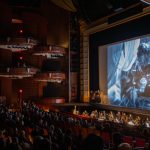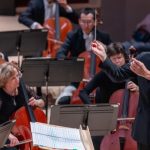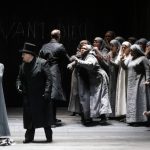November 9, 2025
Spveu Hall
Morrow, Georgia – USA
Isidore Quartet (Adrian Steele & Phoenix Avalon, violins; Devin Moore, viola; Joshua McClendon, cello); Miró Quartet (Daniel Ching & William Fedkenheuer, violins; John Largess, viola; Joshua Gindele, cello).
Franz Josef HAYDN: String Quartet in B Major, Op. 76, No. 4 (“Sunrise”)
Caroline SHAW: Microfictions, Vol. 1
Felix MENDELSSOHN: Octet for Strings in E-flat Major, Op. 20
William Ford | 20 OCT 2025
When I was about twelve, I struggled to learn Kreisler’s The Old Refrain on my violin for a school recital. On the big day, four of us nervous students stood onstage beside our teacher, Ms. Renner. As we began, she launched into a rich, singing version of the piece while we did our best to keep up. That afternoon, I learned some enduring lessons—about experience, ego, stage presence, and the vast difference between playing notes and making music. Our parents told us we were wonderful, of course, but we all knew the truth: Ms. Renner made music.
That early lesson came to mind on Sunday at Spivey Hall, where the Isidore and Miró Quartets shared the stage. The concert became a study in musical maturity—the seasoned mastery of one ensemble meeting the vibrant promise of another, together reminding us how technique becomes art when experience and curiosity meet in perfect balance.
The Isidore String Quartet, founded in 2019 at The Juilliard School, is dedicated to “revisiting, rediscovering, and reinvigorating the repertory,” approaching the established as if it were new and the new as if it were long established. Formed by Adrian Steele and Phoenix Avalon (violins), Devin Moore (viola), and Joshua McClendon (cello), the ensemble quickly rose to prominence after winning the 2022 Banff International String Quartet Competition and receiving an Avery Fisher Career Grant in 2023.
The Miró Quartet, founded in 1995 by students at the Oberlin Conservatory of Music and based in Austin, Texas, serves as quartet-in-residence at the University of Texas at Austin’s Sarah and Ernest Butler School of Music. The current members—Daniel Ching and William Fedkenheuer (violins), John Largess (viola), and Joshua Gindele (cello)—have built an enduring reputation for interpretive depth and tonal beauty. From early victories at the Banff and Naumburg competitions to becoming the first chamber ensemble to receive the Avery Fisher Career Grant in 2005, the Miró quartet’s career has combined refinement with vitality.
Both quartets joined forces after intermission to celebrate the 200th anniversary of Mendelssohn’s Octet in E-flat Major, Op. 20. Before that collaboration, each performed separately: Isidore offered Haydn’s String Quartet in B Major, Op. 76, No. 4 (“Sunrise”), and Miró presented Caroline Shaw’s Microfictions, Vol. 1.
Haydn’s “Sunrise” Quartet (1797) is among the most radiant and imaginative of his late quartets, showing the composer at the height of his powers—confident, expansive, and harmonically daring. Its four movements—“Allegro con spirito,” “Adagio,” “Menuetto: Allegro,” and “Finale: Allegro ma non troppo”—capture the mature Haydn: inventive, playful, and profoundly human. It’s a polished work from the man who defined the string quartet as an art form.
The Isidore Quartet demonstrated both musical and technical excellence, performing with precision, clarity, and strong ensemble unity. Their interpretation was thoughtful and well-shaped, revealing a deep understanding of Haydn’s style. At times, however, the violins projected a bright, almost metallic edge that occasionally seemed at odds with the warmth of the hall’s acoustics. Perhaps this was simply a matter of balance or the seating position, as Spivey Hall’s sound is typically generous to chamber groups. In any case, the quartet’s cohesion and musical insight left a strong impression, and their artistic promise is undeniable.
Caroline Shaw’s Microfictions, Vol. 1—a compact, roughly twenty-minute quartet written for the Miró around 2021—offered a striking contrast. Shaw, one of today’s most acclaimed composers and the youngest-ever winner of the Pulitzer Prize for Music (for Partita for 8 Voices, 2013), has a gift for distilling big ideas into miniature forms.
Each movement of Microfictions is paired with a brief text written by the composer, read aloud by a quartet member before playing. The result feels like a series of sonic vignettes—short, vivid sketches that capture ideas, moods, or fragments rather than long developmental arcs. Shaw uses a remarkable range of string techniques—glissandi, microtones, tone clusters, and pizzicato effects—while constantly shifting texture, register, and articulation.
Though I didn’t always sense a clear link between the texts and the music (except perhaps in the third section, “A Summer Storm”), the piece’s inventiveness and accessibility were undeniable. The Miró players threw themselves into it—visually and physically—as if embodying the music from within. Their commitment and energy brought Shaw’s imaginative score fully to life, a reminder of how contemporary music can communicate complexity with immediacy. And notably, Miró’s violins produced a beautifully balanced tone—bright yet never brittle.
After intermission came the concert’s centerpiece, Mendelssohn’s Octet for Strings in E-flat Major, Op. 20. Mendelssohn conceived the octet as a single, symphonic organism rather than two quartets playing side by side. He marked it “in symphonic style,” meaning that the eight parts fuse into a large, orchestral texture. The work bursts with youthful energy, lyricism, and contrapuntal brilliance, already revealing the imagination that would define his later compositions.
The first movement (“Allegro moderato ma con fuoco)” opens with an upward-striving theme—effervescent, optimistic, and tightly wrought, every idea transformed as it develops. The “Andante” offers a fluid, conversational lyricism; the “Scherzo” (“Allegro leggierissimo”), inspired by Goethe’s Faust, dances with gossamer lightness; and the “Presto” finale races through a jubilant fugue, ending in radiant affirmation.
For this performance, the Miró musicians were seated to stage left (with their cellist sitting to the right of his Isidore counterpart), and violinist Daniel Ching cued the ensemble with confident gestures and an engaging sense of momentum. The combined forces produced a rich, unified sonority that filled Spivey Hall with buoyant energy. The Miró’s experience showed in their relaxed authority and expressive assurance, while the Isidore contributed youthful precision and drive.
If the Miró projected a sense of command born of decades together, the Isidore brought freshness and eagerness. They are still finding their collective voice, but that’s precisely what makes collaborations like this valuable: they show how artistry matures over time. In that sense, the Miró was the Ms. Renner to the Isidore’s younger musicians—an encouraging example of what experience and confidence can add to raw talent.
Spivey Hall offered not just a concert, but a conversation between generations—a reminder that the bridge from notes to music is built by time, experience, and the joy of discovery. ■
EXTERNAL LINKS:
- Isidore Quartet: isidorestringquartet.com
- Miró Quartet: miroquartet.com
- Spivey Hall: spiveyhall.org

Read more by William Ford.
RECENT POSTS
 The Atlanta Opera conjures a night of enchantment as Glass’ score reawakens Cocteau’s ‘La Belle et la Bête’ • 20 Nov 2025
The Atlanta Opera conjures a night of enchantment as Glass’ score reawakens Cocteau’s ‘La Belle et la Bête’ • 20 Nov 2025 Jan Lisiecki on discipline, performance psychology, and programming for his Spivey Hall recital • 17 Nov 2025
Jan Lisiecki on discipline, performance psychology, and programming for his Spivey Hall recital • 17 Nov 2025




.png)